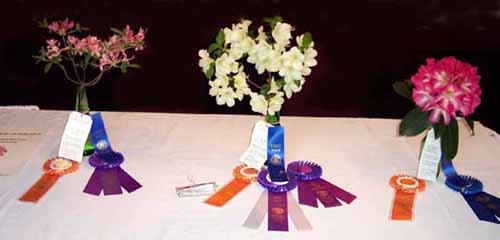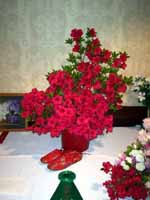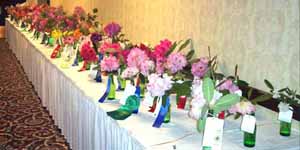Chapter Picnic and Cutting Exchange
Sunday, June 13th 1:00 - 5:00 PM
In addition to our annual picnic at Margaret's place, we will also have a cutting exchange for evergreen and deciduous azaleas as well as the small leaf (lepidote) rhododendrons. If you have some cuttings you are willing to share, please put 3 to 8 of them in a plastic bag and wrap the ends in a moist piece of paper towel. Please label varieties clearly. Don Hyatt's article "Rooting Azalea and Lepidote Rhododendron Cuttings" is in this newsletter but you can ask him for a demo too.
-
Rooting Evergreen Azalea and Lepidote Rhododendron Cuttings
Annual Flower Show

We held our annual Flower Show this year in conjunction with the Azalea Society National Convention in Bowie, MD. Thanks to all who entered and helped with the event. It was a lovely display with approximately 150 entries.
The Sweepstakes went to Bill Bedwell of Dinwiddie, VA, a member of the Middle Atlantic Chapter ARS and also an associate member of our chapter. The lovely trusses and azalea sprays from his garden took many top awards including Best Deciduous Azalea for the pale pink and yellow native hybrid 'Rosy Cheeks', Best Rhododendron for the stunning bicolor red and white 'Consolini's Windmill', and best Evergreen Azalea as well as Best in Show for the flawless spray of the white with green blotch Glenn Dale Azalea 'Puck' that looked almost yellow. Congratulations Bill!
Best In Class:
-
Evergreen Azalea: 'Puck' (Bedwell)
Deciduous Azalea: 'Rosy Cheeks' (Bedwell)
Rhododendron: 'Consolini's Windmill' (Bedwell)

A beautiful arrangement featuring the Back Acres azalea 'Red Slippers' combined with a pair of oriental red slippers was entered by Bob Barry. Since Bob was a floral designer by profession, he asked that his entry not be in competition but the judges gave him a Special Award anyway. A list of all awards is published in the newsletter.
Special Awards:
-
Evergreen Azalea: 'Red Ruffles' (Segree)
Rhododendron: 'Ingrid Mehlquist' (Bedwell)
Floral Arrangement: 'Red Slippers' (Barry)
Evergreen Azaleas:
-
 White Single - 1st: 'Puck' (Bedwell), 2nd: 'Treasure' (McWhorter), 3rd: 'Vespers (Mohr)
White Single - 1st: 'Puck' (Bedwell), 2nd: 'Treasure' (McWhorter), 3rd: 'Vespers (Mohr)
White Double - 1st: 'Hardy Gardenia' (Segree), 2nd: H.H. Hume (Mohr), 3rd: 'Snow' (Duffy)
White with Stripe - 1st: 'Quakeress' (Hobbs), 2nd: unknown (White)
Pale Pink Single - 2nd: 'Bayou' (Hyatt), 3rd: Pink Petals (Newman)
Pale Pink, HH or Double - 1st: 'Appleblossom' (Hyatt), 2nd: 'Spring Dawn' (Scott), 3rd: 'Peggy Ann' (Mohr)
Pale Pink, Small Stem - 1st: 'Amy' (Segree), 2: 'Eliza Hyatt' (Carter), 3rd: 'Pink Pearl' (Mohr)
Pink Single - 1st: 'Wanderer' (Segree), 2nd: 'Tatami' (Gregg), 3rd: 'Robin Hill Frosty' (Goodrich)
Pink, Double - 1st: 'Rosebud' (White), 2nd: Unknown (Duffy), 3rd: Delos (Scott)
Pink with Blotch, Hose in Hose - 1st: Unknown (Hobbs), 2nd: Unknown (Newman)
Light Salmon, Hose in Hose or Double - 1st: 'Guy Yerkes'? (White), 2nd: Unknown (White)
Salmon, Hose in Hose or Double - 1st: Louise Gable (White), 2nd: Unknown (Segree)
Deep Salmon to Coral, HH or Double - 1st: 'Peach Fuzz' (Carter), 2nd: Fashion (White)
Bicolor or Bordered - 1st: 'Ben Morrison' (Hyatt)
Orange Red Single - 1st: Unknown (White), 2nd: 'Chojuho' (Stelloh), 3rd: Unknown (White)
Deep Red Single - 1st: 'Kobold' (Gregg)
Rose Red, Hose in Hose or Double - 1st: Red Ruffles (Segree), 2nd: Hershey Red
Rose Red Single -1st: Maxwellii (White), 2nd: Tara (Newman), 3rd: Lucette (Newman)
Lavender Pink, Bicolor - 2nd: George L. Tabor (Hobbs), 3rd: George L. Tabor (Segree)
Lavender Single - 1st: Koromo Shikibu (Hyatt), 2nd: Betty Anne Hanes (Segree)
Lavender, Hose in Hose or Double - 2nd: Sherbrook (Segree), 3rd: Elsie Lee (Mohr)
Purple Single - 1st: George Hyatt (Carter), 2nd: Winedrop (Stelloh)
First Time Exhibitors: 1st: Unknown (Smith), 2nd: Martha Hitchcock (Smith)
Species: R. kiusianum 'Miyama no Kasami' (Segree)
Deciduous Azaleas:
-
Pink - 1st: Rosy Cheeks (Bedwell), 2nd: Nacoochee Princess (Segree)
Yellow - 2nd: Yellow Lights (Segree), 3rd: Narcissiflora (Gregg)
Orange - 3rd: Unknown (Segree)
Species - 3rd: R. occidentale (Stelloh)
Rhododendrons:
-
Species - 3rd: R. fortunei (Hyatt)
White - 2nd: Dexter's Spice (White)
Pale Pink - 1st: Katherine Dalton (Goodrich)
Pink with Blotch - 1st: Ingrid Mehlquist (Bedwell), 2nd: Ingrid Mehlquist (Segree), 3rd: Professor Amateis (White)
Pink - 1st: Solidarity (Carter), 2nd: Wheatley (Hyatt), 3rd: Betty Wormald (Bedwell)
Deep Pink - 3rd: Anna Rose Whitney (White)
Red - 1st: Redhead (Bedwell)
Red with Blotch - 1st: America (Bedwell), 3rd: Grierosplendor (Bedwell)
Red Bicolor - 1st: Consolini's Windmill (Bedwell), 2nd: Fantastica (Segree)
Cream - 2nd: Hardy Loderi (Segree)
Mixed Yellow and Pink - 2nd: Skyglow (Bedwell)
Lavender with Blotch - 1st: A. Bedford (Bedwell)
Purple - 1st: Purple Splendor (Bedwell), 2nd: Aunt Martha (Bedwell)
New Introductions - 3rd: (Pygmaleon-haematodes) x yellow (Goodrich)
Photography:
-
1st: Azalea, White with red stripes (Hobbs), 2nd: Azalea, Lavender (Hobbs)
Exhibitors:
-
Robert K. Barry, Martinsburg, WV
William F. Bedwell, Dinwiddie, VA
Gray Carter, Easton, MD
Jim and Lois Duffy, Severna Park, MD
Jane Goodrich, Vienna, VA
Diane Gregg, Potomac, MD
Bee and Bob Hobbs, North Beach, MD
Donald Hyatt, McLean, VA
Richard Mohr, Potomac, MD
Jane Newman, Vienna, VA
Gabrielle Scott, Upper Marlborough MD
Carol Segree, Gambrils, MD
John Smith, Stuart, VA
Bob Stelloh, Hendersonville, NC
Margaret K. White, Falls Church, VA
Judges:
-
Barbara Bullock, Donna Coleman, Joe Coleman, Ed Collins, Buddy Lee, Don Voss
Van Veen Plant Order
We will be sending out forms for our group order from Van Veen in late August, as soon as we get their current listing. We have their 2003 version online if you want to plan ahead:
www.donaldhyatt.com/ARSPVC/vanveen.html
Sudden Oak Death
There has been much concern recently about a fungus disease cause by Phytophtora ramorum that is known as Sudden Oak Death (SOD). It was first identified in California in 1995 and has resulted in the loss of thousands of mature trees along the west coast of California and Oregon.
It is not merely a disease affecting oak trees though, but attacks many woody plants including rhododendrons, azaleas, camellias, kalmias, maples, witch hazels, firs, yews, lilacs, roses, and many more plants. There is no known cure and the potential devastation to our eastern forests has raised serious concerns among horticulturists.
The presence of SODs has been found in 14 states so far, and the contamination in Virginia and Maryland came from a shipment of camellia plants from Monrovia Nursery this spring. The diseased plants were seized and destroyed with no further contamination noted. The Virginia Department of Agriculture is requiring inspection of all nursery stock imported from California now. According to a recent article in the Washington Post (May 23, 2004 Section C4) officials say there is no reason for alarm but we should be concerned about potential infection and take measures to avoid it.
The symptoms of SODs do vary from species to species which makes identification difficult. On oak trees, the fungus attacks the cambium layer under the bark causing a red sap to ooze from the trunk, a browning of the branches, and death of the tree within a few weeks. Soon we should start seeing lots of brown branches on our trees but that is from cicadas laying eggs and not likely SODs.
What is a Species?
The following thoughts have come from some recent email discussions about what is a species? Barry Sperling noted that when two species of animals are able to make a hybrid, it is usually sterile such as a mating between a horse a donkey which produces a mule. He asked the question if that were true for all plant species.
The answer is essentially "no" and the problem lies in the definition of a species since mankind has made those distinctions. For some time there have been discussions about what is a species on the Yahoo Rhodo group but there seems to be a general agreement there is no clear definition. You can read the archives at .
Botanically, a species is often determined by what makes sense to scientists having seen large numbers of plants growing in the wild and comparing them to all the other plants that are known. Quite often, plant populations have been geographically isolated from others in the genus for centuries and have now evolved that they are genetically so different that taxonomists say they should be designated as separate species.
This doesn't necessarily mean they that won't cross and produce fertile hybrids with other species though. For instance, among our fifteen East Coast deciduous azalea species, only two generally do not hybridize with anything else and those species are R. vaseyi and R. canadense. The rest of them will cross with one another and will even hybridize with other deciduous azalea species from around world like R. occidentale from our West Coast, R. luteum from the Caucasus in Eastern Europe, or R. japonicum from Japan. Interestingly, R. canadense is so different that it was once considered in a separate genus, Rhodora, and not part of the Rhododendrons.
The "lumpers" in the field of taxonomy might argue that since most of those native azaleas cross freely they should therefore fall into one species group. Perhaps we should give it just one name, something like R. pentanthera which is the Section name within the genus Rhododendron for most of the deciduous azaleas. That would make R. calendulaceum, our Flame azalea which is not fragrant and comes in brilliant shades of yellow, orange, and red, the same species as the fragrant white with red stamens, R. arborescens.
These two forms are clearly different to anyone who sees them and relatively uniform throughout their natural ranges even though they may overlap geographically at times and natural hybrids do occur. According to Clarence Towe who has written a new book on deciduous azaleas due out this fall, R. calendulceum is a natural "allotetraploid" having two complete sets of genes of familiar species: one set from R. prinophyllum (roseum) and the other from R. cumberlandense (bakeri). To lump all of these species together as the same form would not make sense to people who want to raise these plants and talk about them. Because crosses between diploids and tetraploids usually produce sterile triploids, crosses with calendulaceum should produce sterile hybrids but surprisingly, many are fertile.
The "splitters" among the taxonomists often want to declare a new species whenever the type form of an isolated population does not seem to match general species characteristics. There is always an ongoing debate among the two groups and whenever they come to an agreement, I do try to follow the new name designations as best I can.
Recently the lumpers decided that R. molle in China and R. japonicum in Japan were just regional variants of the same species R. japonicum so they have made a name change now. the Chinese azalea is R. japonicum subspecies molle and the Japanese native is R. japonicum ssp. japonicum now. I admit that I will probably will drop the first part whenever I write a name tag.
A similar lumping has been done with some favorite rhododendrons too. At one time we had separate species names for plants known as degronianum, metternichii, and yakushimanum but now taxonomists have decided now that all of these plants are just forms of R. degronianum.
The splitters have noticed some strange variants of R. alabamense that didn't seem to fit the typical form of this fragrant white native azalea with a yellow blotch. They have now declared those plants to be a new species, R. eastmanii. Originally, only 500 plants in just two places in South Carolina were identified but now people are finding pockets of plants suspected to be R. eastmanii all across the south. My eastmanii is white with a yellow botch like alabamense but has a pink tinge and red stamens similar to arborescens. Its fragrance is very strong but much different than either arborescens or alabamense. R. eastmanii reminds me of what I would expect if I crossed the other two.
The truth is that plants don't really care what we call them and the scientists haven't come to any firm decision as to what their "final" names should be either. In a recent email message to the Rhodo group, Bill Sweeney said the current use of species names reminded him of a passage from Lewis Carrol's Through the Looking Glass when Humpty Dumpty says to Alice, "When I use a word it means exactly what I choose it to mean, neither more nor less." So it is with plant species names.
When DNA testing becomes more widespread with plants, we will surely learn much more about the evolutionary relationships between the species and those plant names will likely change again.
|